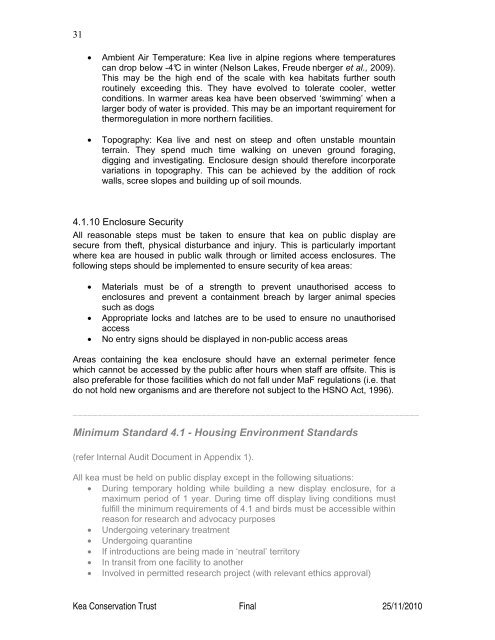(Nestor notabilis) Husbandry Manual - Kea Conservation Trust
(Nestor notabilis) Husbandry Manual - Kea Conservation Trust
(Nestor notabilis) Husbandry Manual - Kea Conservation Trust
You also want an ePaper? Increase the reach of your titles
YUMPU automatically turns print PDFs into web optimized ePapers that Google loves.
31<br />
• Ambient Air Temperature: <strong>Kea</strong> live in alpine regions where temperatures<br />
can drop below -4°C in winter (Nelson Lakes, Freude nberger et al., 2009).<br />
This may be the high end of the scale with kea habitats further south<br />
routinely exceeding this. They have evolved to tolerate cooler, wetter<br />
conditions. In warmer areas kea have been observed ‘swimming’ when a<br />
larger body of water is provided. This may be an important requirement for<br />
thermoregulation in more northern facilities.<br />
• Topography: <strong>Kea</strong> live and nest on steep and often unstable mountain<br />
terrain. They spend much time walking on uneven ground foraging,<br />
digging and investigating. Enclosure design should therefore incorporate<br />
variations in topography. This can be achieved by the addition of rock<br />
walls, scree slopes and building up of soil mounds.<br />
4.1.10 Enclosure Security<br />
All reasonable steps must be taken to ensure that kea on public display are<br />
secure from theft, physical disturbance and injury. This is particularly important<br />
where kea are housed in public walk through or limited access enclosures. The<br />
following steps should be implemented to ensure security of kea areas:<br />
• Materials must be of a strength to prevent unauthorised access to<br />
enclosures and prevent a containment breach by larger animal species<br />
such as dogs<br />
• Appropriate locks and latches are to be used to ensure no unauthorised<br />
access<br />
• No entry signs should be displayed in non-public access areas<br />
Areas containing the kea enclosure should have an external perimeter fence<br />
which cannot be accessed by the public after hours when staff are offsite. This is<br />
also preferable for those facilities which do not fall under MaF regulations (i.e. that<br />
do not hold new organisms and are therefore not subject to the HSNO Act, 1996).<br />
______________________________________________________________________<br />
Minimum Standard 4.1 - Housing Environment Standards<br />
(refer Internal Audit Document in Appendix 1).<br />
All kea must be held on public display except in the following situations:<br />
• During temporary holding while building a new display enclosure, for a<br />
maximum period of 1 year. During time off display living conditions must<br />
fulfill the minimum requirements of 4.1 and birds must be accessible within<br />
reason for research and advocacy purposes<br />
• Undergoing veterinary treatment<br />
• Undergoing quarantine<br />
• If introductions are being made in ‘neutral’ territory<br />
• In transit from one facility to another<br />
• Involved in permitted research project (with relevant ethics approval)<br />
<strong>Kea</strong> <strong>Conservation</strong> <strong>Trust</strong> Final 25/11/2010












